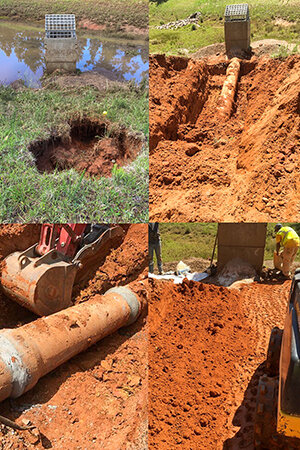Meet Dragonfly’s Charlotte Stormwater Contracting Crew!
Michael, Jeremy, and Ryan are part of Dragonfly’s contracting division, completing some of our largest projects. To highlight their experience, we had each team member pick a recent project that illustrates their extensive capabilities in repairing and constructing stormwater systems and all of their components.
From left: Michael, Ryan, and Jeremy
Michael
Background:
I started as an intern with Dragonfly in the summer of 2017, working in the contracting division, and came back the following summer working in all areas. After I graduated, I came on full-time and then moved to Charlotte to help start the contracting division there in March of 2019.
What makes work in Charlotte particularly interesting?
I think what makes Charlotte projects different and interesting is that we get the chance to fix a lot of systems that have been neglected for quite a while. The Charlotte area is really starting to tighten up on stormwater control measure regulations and we get the chance to make big transformations.
What do you enjoy most about your work?
I really like the diversity of the work. One day you could be patching a riser and the next you could be regrading a stormwater pond bottom. It keeps work interesting and I’m always learning something new.
Advice for future employees:
Work hard and learn as much as you can about stormwater.
The project I’d like to highlight is a big one where we restored two dry ponds. I found this one fun and challenging. On both stormwater control measures, or SCM’s, we cleared all of the trees and woody vegetation, then grubbed and graded all of the slopes. We also dredged sediment out of both dry pond basins and then regraded the basins to promote positive drainage. All of the inlets and outlets received new riprap aprons and dissipator pads. Both ponds had new overflow spillways installed and were seeded and stabilized once all of the work was completed.
What stuck out to me on this project was that on the second dry pond, we noticed that the riser and outlet pipe were corroded and could have led to an eventual dam failure. To fix this, we installed a new concrete riser structure and new reinforced concrete pipe through the dam. Before setting the riser, we poured an anti-float block to anchor the structure down. This was the first time I had installed one of these, which was a fun process to learn.
We also replaced a reinforced concrete pipe leading into the first pond. We had to cut and remove the asphalt to expose the pipe and haul the old pipe out.
We then installed the new pipe, backfilled the area with proper compaction, and prepped the disturbed area for an asphalt subcontractor.
All in all, I think this project summarizes a lot of the work Dragonfly can complete. From the clearing and regrading of a stormwater system, all the way down to just a simple dissipator pad install.
Jeremy
Background:
I’ve been with Dragonfly since April, 2020. I was drawn to work for Dragonfly because it’s a company in a field I’m very interested in and familiar with as well. Prior to starting with Dragonfly, I was already certified in SCM and had 3+ years of stormwater experience.
What makes work in Charlotte particularly interesting?
I like the variety of work that we do in Charlotte. Every pond or stormwater system is different, so we’re never doing the exact same thing. The work that we do requires you to not only incorporate your skills but also your mind in problem solving for the various systems we encounter.
Advice for future employees:
Learn to be resourceful and be comfortable with adapting to different projects and conditions.
The project I want to highlight is one that I found interesting and enjoyed for several reasons. This project involved a pretty large blowout to the back of a stormwater pond dam and a sinkhole on the front of the dam. This was caused by pipe separations. We started out by excavating the sinkhole on the front of the dam along the outlet pipe. We sealed the joints in the pipe with hydraulic cement and then backfilled the area with new material and proper compaction.
Next, we excavated the outlet pipe through the back of the dam. We installed two concrete anti-seep collars on the separated joints near an existing collar. We also exposed and sealed every joint between the collars and the flared end section.
We backfilled all of the excavated areas and compacted the fill material in lifts. Finally, the dam was reshaped back to grade and we stabilized all of the disturbed areas with matting and grass seed.
One of the reasons I enjoyed this project so much was due to the opportunity to learn how to use a new machine, a Trac Truck. Our access point was a good distance from the dam, so we used the Trac Truck to transport our supplies. I also enjoyed working on an erosion project this big. The weather presented a challenge in finishing this project. In the end, I was very proud of our work to restore this system given the challenges and scope of work involved.
Ryan
Background:
I started working for Dragonfly in July, 2020. After graduating from ECU, I was looking for a position that offered experience in the field and was more hands on. Being able to use machinery was a plus.
What makes work in Charlotte particularly interesting?
Charlotte is enforcing stormwater regulations more now and because of that we get the opportunity to go in and fix big issues that haven’t been addressed in years.
What do you enjoy most about your work?
I like using machines and seeing the transformation from when we arrive on site to project completion.
Advice for future employees:
Be prepared to work hard, some days are easier than others.
One project I found interesting and really enjoyed was one in Myrtle Beach. We primarily work in the Charlotte area, however, there are times when we may be needed in another location. For this project we completed about 1500 linear feet of shoreline restoration for two ponds. We used coir logs for this shoreline restoration. Coir logs are staked along a bank to protect it from erosion.
To complete this shoreline restoration, we started by regrading the eroded shoreline to the desired slope. We then installed the coir logs along the bank. Fill dirt was used to backfill some areas behind the coir logs. As always, we stabilized all of the disturbed areas with matting and grass seed.
This project presented us with a few challenges, mainly because we were working in people’s backyards. This made moving around with our machines tricky because sometimes a direct path was blocked by fences or trees and we wanted to make sure we didn’t cause any damage to the homeowner’s properties. We moved mats around for the machinery so that we wouldn’t leave tracks. What I really enjoyed about this project was speaking with the homeowners and hearing them say how glad they were that we saved their yard. Some people had lost 8 feet of their yard to the eroding shoreline. This project was tedious and slow moving at times, but it was definitely rewarding.
Michael, Jeremy, and Ryan possess an immense skillset in stormwater repair and construction and they are always excited about the opportunity to learn something new. Dragonfly is fortunate to have these passionate individuals leading our Charlotte contracting branch. Thank you to the three of them for sharing their insight!
Learn more about our Team and Dragonfly Pond Works Careers.
Subscribe to our newsletter to receive informative and engaging news delivered right to you inbox.









